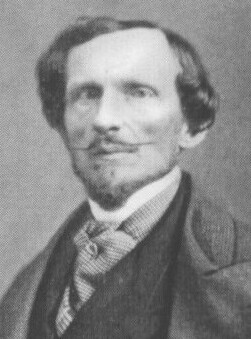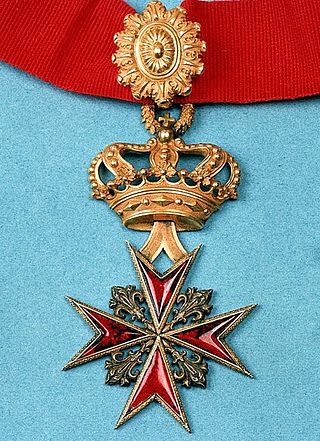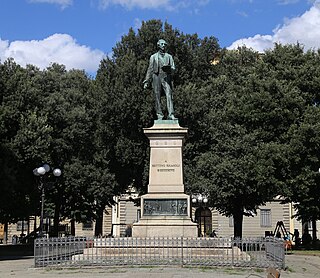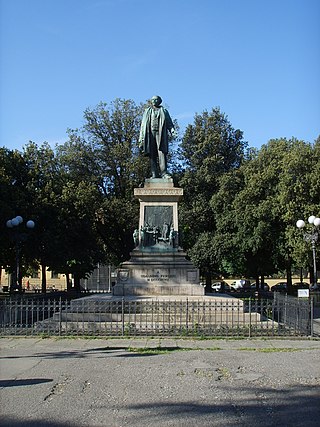
A Chianti wine is any wine produced in the Chianti region of central Tuscany. It was historically associated with a squat bottle enclosed in a straw basket, called a fiasco. However, the fiasco is now only used by a few makers of the wine; most Chianti is bottled in more standard-shaped wine bottles. In the mid-to-late 19th century, Baron Bettino Ricasoli helped establish Sangiovese as the blend's dominant grape variety, creating the blueprint for today's Chianti wines.

Florence is the capital city of the region of Tuscany in Central Italy. It is also the most populated city in Tuscany, with 360,930 inhabitants in 2023, and 984,991 in its metropolitan area.
Charles-Antoine Campion, italianized as Carlo Antonio Campioni was a French-Italian composer who was born in Lorraine, France. He was a prolific composer and represented a link between Baroque compositional methods and those of the Classical style.

Bettino Ricasoli, 1st Count of Brolio, 2nd Baron Ricasoli was an Italian statesman. He was a central figure in the politics of Italy during and after the unification of Italy. He led the Moderate Party.

The Frescobaldi are a prominent Florentine noble family that have been involved in the political, social, and economic history of Tuscany since the Middle Ages. Originating in the Val di Pesa in the Chianti, they appear holding important posts in Florence in the twelfth century.

Montepulciano is a medieval and Renaissance hill town and comune in the Italian province of Siena in southern Tuscany. It sits high on a 605-metre (1,985 ft) limestone ridge, 13 kilometres (8 mi) east of Pienza, 70 kilometres (43 mi) southeast of Siena, 124 kilometres (77 mi) southeast of Florence, and 186 kilometres (116 mi) north of Rome by car.
Marquis Ferdinando Bartolommei was an Italian revolutionist and statesman who played an important part in the political events of Tuscany from 1848 to 1860.

Teodulo Mabellini was an Italian composer.

The Order of Saint Stephen is a Roman Catholic Tuscan dynastic military order founded in 1561. The order was created by Cosimo I de' Medici, first Grand Duke of Tuscany. The last member of the Medici dynasty to be a leader of the order was Gian Gastone de Medici in 1737. The order was permanently abolished in 1859 by the annexation of Tuscany to the Kingdom of Sardinia. The former Kingdom of Italy and the current Italian Republic also did not recognize the order as a legal entity but tolerates it as a private body.

Tuscan wine is Italian wine from the Tuscany region. Located in central Italy along the Tyrrhenian coast, Tuscany is home to some of the world's most notable wine regions. Chianti, Brunello di Montalcino and Vino Nobile di Montepulciano are primarily made with Sangiovese grape whereas the Vernaccia grape is the basis of the white Vernaccia di San Gimignano. Tuscany is also known for the dessert wine Vin Santo, made from a variety of the region's grapes. Tuscany has forty-one Denominazioni di origine controllata (DOC) and eleven Denominazioni di Origine Controllata e Garantita (DOCG). In the 1970s a new class of wines known in the trade as "Super Tuscans" emerged. These wines were made outside DOC/DOCG regulations but were considered of high quality and commanded high prices. Many of these wines became cult wines. In the reformation of the Italian classification system many of the original Super Tuscans now qualify as DOC or DOCG wines but some producers still prefer the declassified rankings or to use the Indicazione Geografica Tipica (IGT) classification of Toscana. Tuscany has six sub-categories of IGT wines today.

The history of Chianti dates back to at least the 13th century with the earliest incarnations of Chianti as a white wine. Today this Tuscan wine is one of Italy's most well known and recognizable wines. In the Middle Ages, the villages of Gaiole, Castellina and Radda located near Florence formed as a Lega del Chianti creating an area that would become the spiritual and historical "heart" of the Chianti region and today is located within the Chianti Classico Denominazione di Origine Controllata e Garantita (DOCG). As the wines of Chianti grew in popularity other villages in Tuscany wanted their lands to be called Chianti. The boundaries of the region have seen many expansions and sub-divisions over the centuries. The variable terroir of these different macroclimates contributed to diverging range of quality on the market and by the late 20th century consumer perception of Chianti was often associated with basic mass-market Chianti sold in a squat bottle enclosed in a straw basket, called fiasco.
Auser Musici is a period instrument ensemble centered in Pisa that specializes in early music repertory from the Tuscan region of Italy.

A Monument to Bettino Ricasoli is a Bronze statue with a plinth adorned with two bronze bas-reliefs that honors the 19th-century Italian patriot and statesman, Bettino Ricasoli, and is located in the Piazza dell'Indipendenza in Florence, region of Tuscany, Italy.

The Monument to Ubaldino Peruzzi is a bronze statue erected in 1608 in the Piazza dell'Indipendenza in Florence, region of Tuscany, Italy.

Ferdinando Giorgetti was a composer, violinist, educator and Italian publicist.
The Venturi Music Collection is a collection of musical documents housed at the Public Library in Montecatini Terme, Italy. It conserves many handwritten copies by composers who were active in the second half of the 1700s; for example, there are autographs, which are one of a kind, of composers from the Pistoia and Florence area.

Alessandro Felici was an Italian composer and violinist, not to be confused with his contemporary, Roman composer Felice Alessandri.

The flag of Tuscany is the official flag of the region of Tuscany, Italy. The flag depicts a silver Pegasus rampant on a white field between two horizontal red bands. The flag first appeared as a gonfalon on 20 May 1975 along with accompanying text Regione Toscana above the Pegasus. It was officially adopted as the flag of Tuscany on 3 February 1995.

The Tuscan Committee of National Liberation was an underground Italian resistance organisation during World War II based in Tuscany, Central Italy. An offshoot of the National Liberation Committee (CLN), it was charged with organising resistance and partisan activities throughout Tuscany. It was opposed to the forces of Nazi Germany as well as Nazi Germany's puppet state local regime, the Italian Social Republic, in Tuscany following the German invasion and military occupation of Italy between September 1943 and April 1945. The CTLN became an umbrella organisation for the five main anti-fascist partisan groups operating within Tuscany.